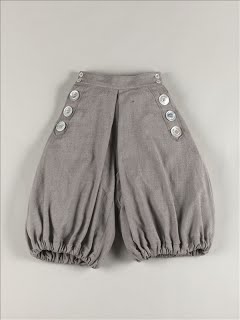Bloomers are a bifurcated garment that were worn under dresses in the 19th century. They soon became a symbol of women’s rights because early activist Amelia Bloomer wore drawers long enough to stick out from under her dress.
The Details
Phyllis Tortora and Keith Eubank write of bloomers in the Survey of Historic Costume (2010):
“The costume suffragists saw as preferable to fashionable dress was called the ‘Bloomer costume’ after Amelia Bloomer, one of the women who wore this full-skirted, short dress that was placed over full trousers.” (302)
The Fairchild Books Dictionary of Fashion, written by Phyllis Tortora, defines the bloomer costume as a:
“Knee length dress worn over pants gathered at the ankle. Costume was modeled after clothing worn in health sanitariums, and adopted by women’s rights advocates of the 1850s. Although she did not originate the style, Amerlia Jenks Bloomer (1818-1894), writer and lecturer on women’s rights, wrote favorably about and wore this costume for her lectures; thus, it was named after her. Although the style did gain acceptance as women’s attire, suitable for exercising and athletic activities, it was not widely adopted. Since the 1850s, full pants gathered at the hem are still called bloomers.” (26-27)
Author Georgina O’Hara Callan of the Dictionary of Fashion and Fashion Designers gives the definition:
“Since the late 19th century, the word bloomers describes any loose, full, trouser-like garment which is gathered at some point between the knee and ankle and worn under long skirts.” (36)
Valerie Cumming wrote in the Dictionary of Fashion History:
“Name given to young women who imitated the American Mrs Amelia Bloomer in wearing a modified form of trousers below a knee-length full skirt.”
Amelia Bloomer is quoted in the Encyclopedia of Clothing and Fashion as having explained:
“‘Our skirts have been robbed of about a foot of their former length, and a pair of loose trousers of the same material as the dress, substituted. These latter extend from the waist to the ankle, and may be gathered into a band … We make our dress the same as usual, except that we wear no bodice, or a very slight one, the waist is loose and easy, and without whalebones … Our skirt is full, and falls a little below the knee.'” (Callahan)
Figure 2 is a print made in 1851, when the bloomer era was just arising. Of 1895 cycling bloomers (Fig. 3), the Musée de la Mode de la Ville de Paris writes:
“Cycling was all the rage among the French upper classes in the 1880s and, especially, the 1890s. For the bourgeoisie, this new leisure activity required appropriate dress which had to be invented: since there was no tradition to abide by, people opted above all for comfort and practicality, with an emphasis on durability, as in this case, or on the softness of fabrics like jersey.”
Fig. 1 - Unknown. Amelia Bloomer, 1849. Source: Laphams Quarterly
Fig. 2 - William Spooner (British). Portrait of Miss Woolgar as Mrs Portia Lucretia Green in the farce 'Bloomerism', October 27, 1851. Lithograph; 35.3 x 24.8 cm. London: Victoria & Albert Museum, S.492-2011. Gabrielle Enthoven Collection. Source: V&A Museum
Fig. 3 - Designer unknown. Cyclist's bloomers, 1895-1900. Mottled grey wool twill, mother of pearl buttons. Paris: Palais Galliera, musée de la Mode de la Ville de Paris, GAL1995.122.X. Source: Galliera
Its Afterlife
Modern designers sometimes created updated versions of bloomer, like Miu Miu’s Spring/Summer 2008 (Fig. 4) look. Bloomers were hinted at in this mini “skort”-like moment with the fullness of it and the synched bottom of the under layer short that would typically have fallen at the ankle in the 19th century. Fendi’s Spring/Summer 2016 collection featured bloomer-like fullness at the top around the thigh.
Fig. 4 - Miu Miu (Italian). Modern bloomers, S/S Runway 2008. Source: Wordpress
Fig. 5 - Fendi (Italian). Ready-To-Wear Collection, Spring/ Summer 2016. Indigital. Source: Vogue
References:
- “Bloomers (Clothing).” Wikipedia, May 30, 2017. https://en.wikipedia.org/w/index.php?title=Bloomers_(clothing)&oldid=782936739.
- Callahan, Colleen R. “Bloomer Costume.” In Encyclopedia of Clothing and Fashion, edited by Valerie Steele, 161-163. Vol. 1. Detroit: Charles Scribner’s Sons, 2005. Gale Virtual Reference Library (accessed September 24, 2016). http://libproxy.fitsuny.edu:2200/ps/i.do?p=GVRL&sw=w&u=fitsuny&v=2.1&it=r&id=GALE%7CCX3427500078&asid=6c9595055687189a2654486f416ba51f.
- Callan, Georgina O’Hara. The Thames and Hudson Dictionary of Fashion and Fashion Designers. Revised, Expanded and updated edition. World of Art. New York: Thames and Hudson, 2007. http://www.worldcat.org/oclc/953426961.
- Cumming, Valerie, C. W. Cunnington, and P. E. Cunnington. “Bloomers.” In The Dictionary of Fashion History, 23. Oxford: Berg Publishers, 2010. Accessed September 24, 2016.https://www.bloomsburyfashioncentral.com/products/berg-fashion-library/dictionary/the-dictionary-of-fashion-history/bloomers.
- Tortora, Phyllis G., and Keith Eubank. Survey of Historic Costume: A History of Western Dress. 5th ed. New York, NY: Fairchild Publications, 2010. http://www.worldcat.org/oclc/967772873.
- Tortora, Phyllis G., Sandra J. Keiser, and Bina Abling. The Fairchild Books Dictionary of Fashion. 4th edition. New York, NY: Fairchild Books, an imprint of Bloomsbury Publishing Inc, 2014. http://www.worldcat.org/oclc/900349357.















